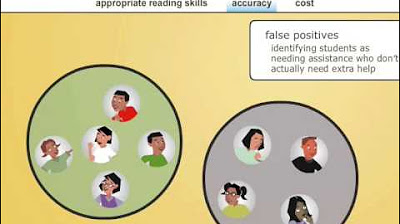Module 5 Section 4
Summary
TLDRThis script discusses the role of universal screenings in a multi-tiered system of support for reading instruction. It outlines how assessments at different tiers identify students' needs and guide instruction. The script explains the importance of a comprehensive assessment system, including screening, diagnostic, progress monitoring, and outcome assessments, to ensure that 80% of students achieve proficiency through tier 1 instruction.
Takeaways
- 📊 Universal screenings are essential for assessing the effectiveness of tier 1 instruction for all students.
- 🔍 A comprehensive assessment system is necessary to understand how students respond to classroom reading instruction.
- 🎓 In a multi-tiered system, about 80% of students should be successfully taught with tier 1 instruction.
- 📉 Approximately 15% of students may need tier 2 intervention, while only about 5% should need tier 3 intensive intervention.
- 📚 Ohio's assessment system includes four types of assessments: screening, diagnostic, progress monitoring, and outcome assessments.
- 👥 Universal screening assessments are given to all students in grades K-3 to identify those needing further evaluation.
- 📝 Diagnostic assessments identify student strengths and weaknesses to support differentiated instruction.
- 📈 Progress monitoring assessments measure student learning more frequently and are tailored to student needs.
- 🏆 Outcome assessments evaluate the effectiveness of tier 1 instruction with the goal of meeting 80% of student needs.
- 🔑 The Problem-Solving Model in Ohio's Dyslexia Guidebook includes all four types of assessments for a structured approach to student support.
- 📖 Universal screening uses normed standardized measures to determine if a student is making sufficient progress.
- 📆 Universal screeners should be administered multiple times a year to measure student growth.
- 📋 The data from universal screening should guide instructional decisions and inform support needs for educators.
Q & A
What is the purpose of universal screenings in education?
-Universal screenings are designed to check the effectiveness of tier 1 instruction for all students and to understand how they are responding to classroom reading instruction.
What percentage of students should be successfully met with tier 1 or core instruction in a multi-tiered system of support?
-Approximately 80 percent of students should have their needs met with tier 1 or core instruction.
What percentage of students typically require tier 2 intervention?
-Approximately 15% of students may require more strategic and targeted intervention in tier 2.
How often should universal screeners be administered in an ideal setting?
-Universal screeners should ideally be administered in the fall, winter, and spring.
What are the characteristics of an effective screening assessment?
-An effective screening assessment must be valid, reliable, and have sufficient diagnostic accuracy.
What does valid mean in the context of assessment?
-In the context of assessment, valid means the measure assesses what it is intended to measure, including foundational reading skills.
What is the role of diagnostic assessments in the multi-tiered system of support?
-Diagnostic assessments are used to identify specific strengths and weaknesses of students and to support teachers in planning differentiated instruction in tier 1.
What is the purpose of progress monitoring assessments?
-Progress monitoring assessments are designed to measure student learning and growth over time, with the frequency determined by student needs.
How does the outcome assessment fit into the comprehensive assessment system?
-The outcome assessment evaluates the effectiveness of tier 1 instruction with the goal of ensuring that 80% of students are getting their needs met within tier 1.
What is the Problem-Solving Model mentioned in the script?
-The Problem-Solving Model is a process that includes problem identification, analysis, plan development and implementation, and plan evaluation, all based on assessment results.
What are the key skills measured by universal screening assessments in tier 1 for kindergarten and 1st grade?
-For kindergarten and 1st grade, universal screening assessments should include phonemic awareness, letter naming, letter-sound correspondence, and real and non-word reading.
How does the focus of universal screening change from 3rd grade and beyond?
-From 3rd grade and beyond, universal screenings should largely focus on assessing oral reading fluency and comprehension.
Outlines

This section is available to paid users only. Please upgrade to access this part.
Upgrade NowMindmap

This section is available to paid users only. Please upgrade to access this part.
Upgrade NowKeywords

This section is available to paid users only. Please upgrade to access this part.
Upgrade NowHighlights

This section is available to paid users only. Please upgrade to access this part.
Upgrade NowTranscripts

This section is available to paid users only. Please upgrade to access this part.
Upgrade NowBrowse More Related Video
5.0 / 5 (0 votes)





